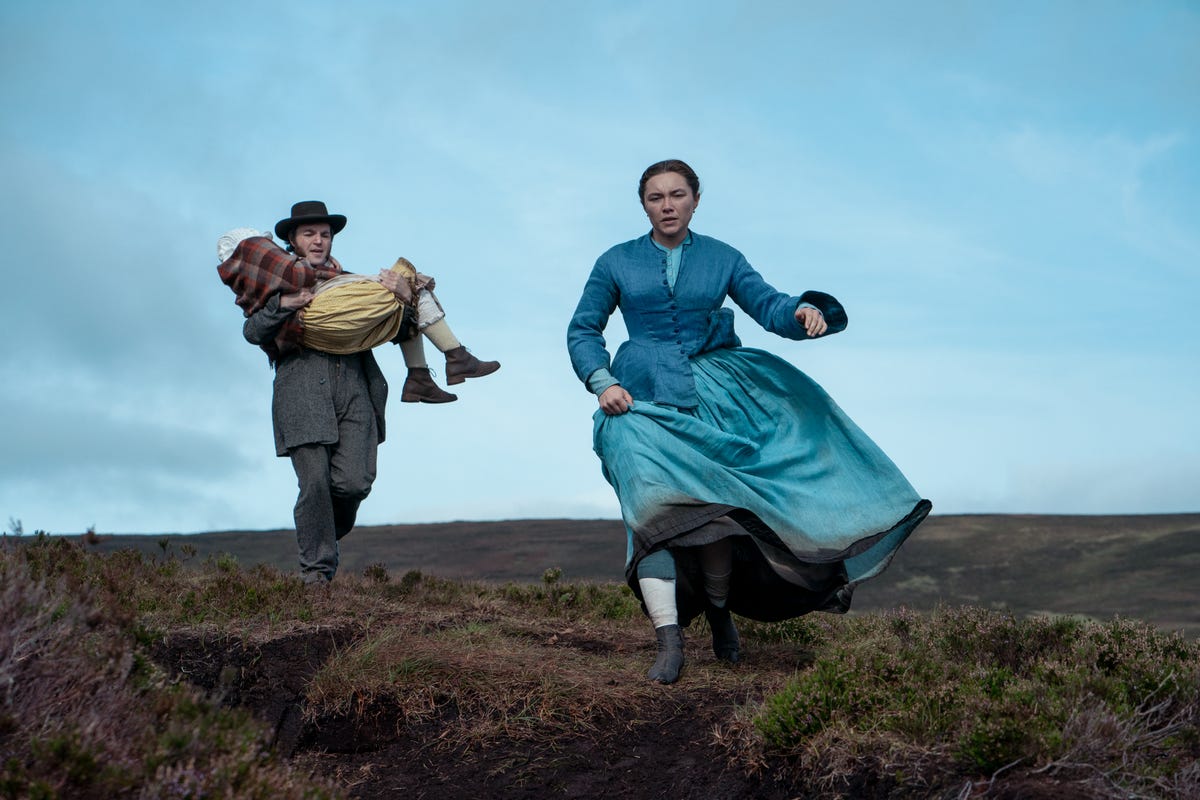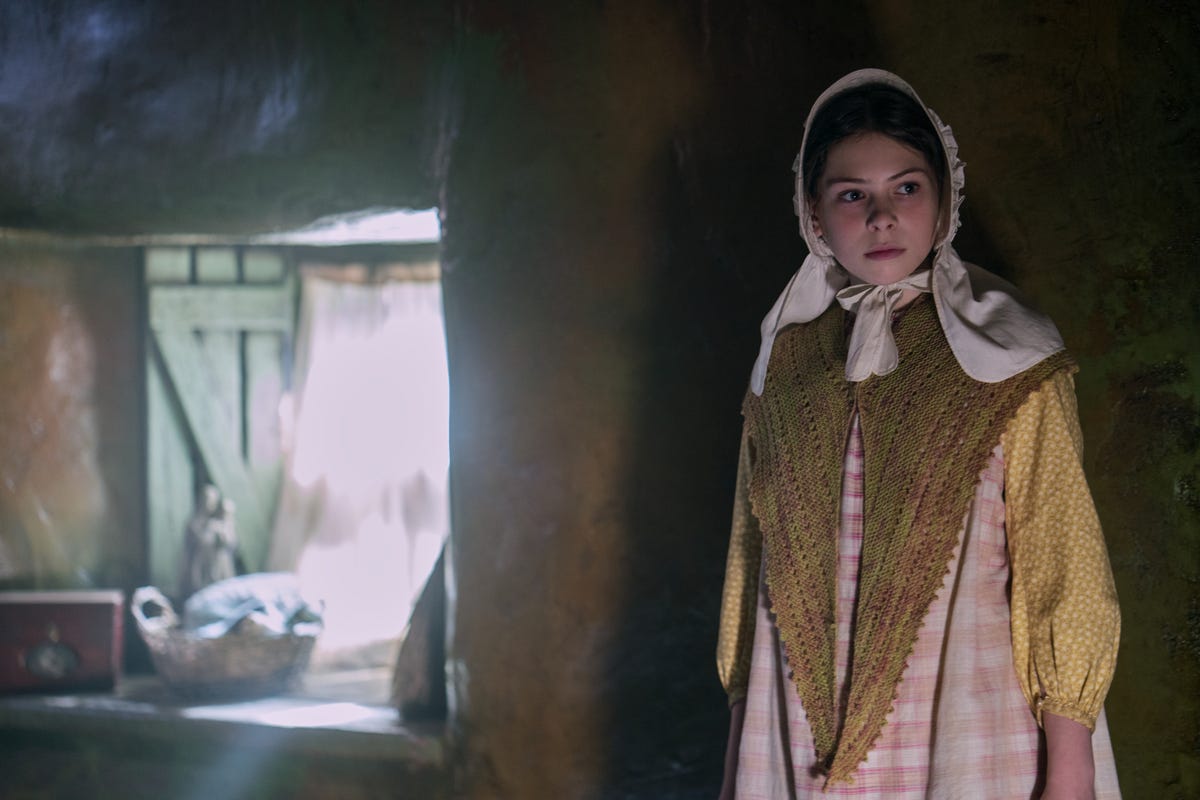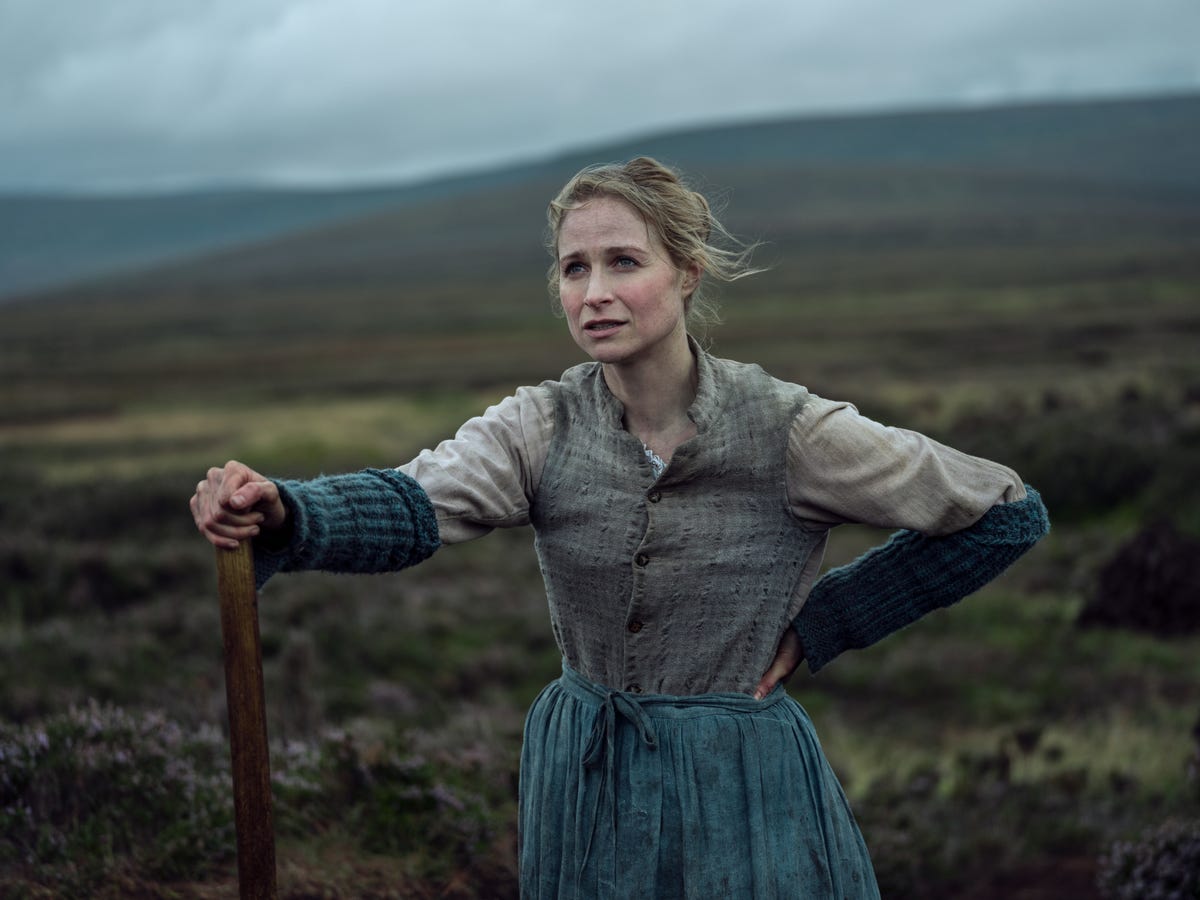
If you just caught The Wonder now that it’s streaming on Netflix, you might be pondering that somewhat jarring ending. The psychological drama from Chilean director Sebastián Lelio asks you to believe in the power of storytelling and how it can alter reality. Case in point: The young girl visited by Pugh’s Nurse Lib Wright claims to be able to survive without food, but really someone might be spinning an incredible yarn.
Let’s quickly run through the themes of The Wonder, what turns out to be true in the story and why it opens and ends in such an odd way.
Warning: Spoilers ahead.
What’s with that weird opening?
You might have been double-checking what movie you’d put on after that strange beginning to the period drama. To the sounds of haunting choral voices, we see the semi-built structure of an old-fashioned two-storey house. The camera pans through what appears to be a lot in a film studio, filled with equipment and other pieces of set. Then actor Niamh Algar says in voiceover: “Hello. This is the beginning. The beginning of a film called The Wonder. The people you’re about to meet, the characters, believe in their stories with complete devotion. We are nothing without stories, and so we invite you to believe in this one.”
The camera then stops on the interior of a ship sailing to Ireland in 1862, where the Great Famine “still casts a long shadow and the Irish hold England responsible for that devastation.” It zooms in on Florence Pugh, who plays English nurse Lib Wright, the main character of the tale.

William (Tom Burke), Anna (Kíla Lord Cassidy) and Nurse Lib Wright (Florence Pugh).
Netflix
Yep, it’s all a tad pretentious. But it effectively sets up the main theme of the film: the power of belief. The whole reason Nurse Wright is summoned by a self-appointed committee to Ireland is that many want to believe Anna O’Donnell has miraculously lived without food for four months. Nurse Wright is enlisted to watch the girl for two weeks to determine how she’s still alive.
This framing also sets us up to be aware of the transportive power of storytelling — pretty quickly you’re immersed in the creaking, drippy, smokey world of the ship and Nurse Wright’s journey, a journey the narrator has invited us to believe in.
What does Nurse Wright drink every night?
What’s real and what isn’t is also represented in Nurse Wright’s addiction to what looks to be liquid opioids. Nurse Wright has suffered her fair share of tragedy — her baby daughter died and her husband left her soon after — and the night cap might be a way of helping her cope. Pricking her finger with blood could be a way of checking she’s still alive — or it could be a form of self-harm. Amid the stresses of her current job, the ritual seems to further loosen Nurse Wright’s grip on reality.

Anna (Kíla Lord Cassidy) refuses to eat because of her beliefs.
Netflix
Is it true that Anna doesn’t really need to eat?
Not long into Nurse Wright’s stay with the O’Donnell family, we see young Anna’s mother lean in pretty close to her daughter’s face while she’s in bed. It either looks like a loving kiss on the forehead or something more disturbing. Nurse Wright soon escalates her watch of the miracle patient by insisting the O’Donnells no longer come close to Anna. From this point onward, Anna’s condition deteriorates rapidly.
About two-thirds through the film, after summoning the committee, Nurse Wright reveals her assessment of the situation: “Anna’s mother, Mrs. O’Donnell, has been passing her food from her own mouth. She cups her face and kisses her good morning and good night, and she feeds her daughter with each kiss, like a bird.” With Anna’s mother prevented from kissing Anna, Anna quickly becomes ill, no longer receiving any sustenance at all.
Why does Anna refuse to eat?
Even after Nurse Wright reveals her findings to the committee, Anna’s mother refuses to admit the truth. She and her husband are willing to let the experiment continue, even if Anna dies, refusing to give up their religious beliefs. In any case, Anna has “chosen” the path to death, believing that if she dies, “one soul will be released… from Hell.” Anna thinks this soul will be her brother, who molested her when she was 9 for years before he died. He was “punished” for the “Unholy” act with deadly illness, but their mother says he’ll be released to Heaven with Anna’s sacrifice. Anna believes this is her duty because she loved her brother back.

Kitty (Niamh Algar), Anna’s sister, who also ends up being the narrator.
Netflix
What’s with the narrator at the end?
In the end, Nurse Wright uses the power of storytelling and belief to save Anna. After discovering the horrifying narrative Anna’s mother has fed her, Nurse Wright convinces Anna of a different fate: That she can die and make her sacrifice, but also be reborn as a 9-year-old again who didn’t suffer terrible acts. Mixing the opioid liquid with milk, Nurse Wright induces Anna into a trance-like state in which she experiences rebirth, assuming the new identity of “Nan.”
Nurse Wright fakes a report of Anna dying so the committee don’t press charges against her and burns down the O’Donnell’s house so evidence of a body appears to be destroyed. Escaping Ireland, Nurse Wright, William and Nan safely make it to Australia, posing as the Cheshire family. There, we see them partake in a fancy meal, with Nan shown to be eating again.
To the sound of more hopeful, ethereal tones, the camera pans and we return to the film studio. There, we see Algar dressed in all black, no longer playing Anna’s older sister Kitty, but the mysterious narrator. She whispers: “In. Out. In. Out.” Again, pretentious, but this goes back to the idea of believing in stories and the power of faith.
